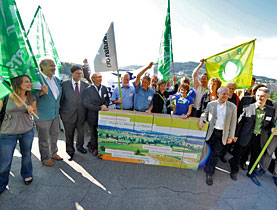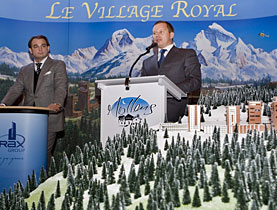Countryside succumbs to urban sprawl

More than a blot on the landscape, urban sprawl is spreading rapidly into Switzerland's pristine alpine regions, according to a study released on Wednesday.
The Swiss National Science Foundation reports that regions including the southern part of canton Ticino and the southwestern canton of Valais are being increasingly affected by development.
The study, which used new techniques to map human settlement in the country, was carried out by researchers at the Institute of Terrestrial Ecology at the Federal Institute of Technology in Zurich.
The Science Foundation has warned that in the absence of counter-measures sprawl will continue in Switzerland, where 176 people on average occupy every square kilometre.
“Urban sprawl is tied to significant environmental, social and economic consequences,” the Science Foundation wrote, adding that it could lead to a loss of recreational and nature areas and higher costs for infrastructure and public services.
They are recommending region-specific benchmarks to direct the placement of new buildings.
No surprise
The Science Foundation said that while the negative effects of sprawl were no surprise, researchers had for a long time lacked the means by which to observe spatial patterns of settlement.
The Zurich-based team led by Jochen Jaeger – an expert in landscape fragmentation – conducted for the first time a national survey of urban sprawl taking into account development since 1935 and combining it with projections through 2050.
The high growth rate of sprawl was reflected in three metrics: dispersion, urban penetration and encroachment per inhabitant.
The dispersion measure is an indication of the spatial distribution of the Swiss population, while the latter two categories reflect the relationship between settlement areas and population.
Researchers found that in 2002 development in some spots claimed nearly four times as much land as in 1935.
The highest growth rates were found in cantons Valais, Nidwalden, Basel Country, Solothurn, Ticino and Geneva.
“In 1935, city limits were clearly identifiable,” wrote the Science Foundation. This is no longer the case, and many urban areas snake into valleys and along transit routes.
Agglomerations
According to the Federal Spatial Development Office, three-quarters of Swiss people live in these urban tendrils, which can stretch far into the countryside.
Once uninhabited areas in the Jura and the Alps have almost completely disappeared.
Researchers are proposing benchmarks to limit urban sprawl. In August 2008, a coalition of environmental organisations submitted more than 110,000 signatures to the government in support of a 20-year moratorium on new growth.
One of the problems, sprawl opponents say, is Switzerland’s decentralised decision-making system. The country’s 26 cantons and 2,700 local authorities for the most part have independent decision-making powers when it comes to planning matters.
The cabinet is due to discuss the country’s spatial development laws next year.
swissinfo with agencies
The project looked at how development of roads and homes has carved up the Swiss landscape between 1935 and 2002. It also projected development through 2050.
The study examined maps of remaining, undeveloped land and the spatial arrangement of development. It also looked to pinpoint trends in future development.
On this basis, researchers believe the project can help communities make recommendations for controlling sprawl by developing appropriate development plans.
The study can also give indications about the dangers facing biodiversity as wildlife migration patterns and habitat battle highways and neighbourhoods.
Switzerland is the eighth most densely populated country in Europe.
The microstate of Malta, just below italy, is the most densely-populated. On average, 1,261 people live on each square metre there.
These countries (not including Monaco, Andorra, San Marino and Vatican City) round out the top ten in Europe:
2. The Netherlands (395)
3. Britain (246)
4. Germany (232)
5. Liechtenstein (216)
6. Italy (193)
7. Luxembourg (186)
8. Switzerland (176)
9. Czech Republic (132)
10. Denmark (127)

In compliance with the JTI standards
More: SWI swissinfo.ch certified by the Journalism Trust Initiative











You can find an overview of ongoing debates with our journalists here . Please join us!
If you want to start a conversation about a topic raised in this article or want to report factual errors, email us at english@swissinfo.ch.